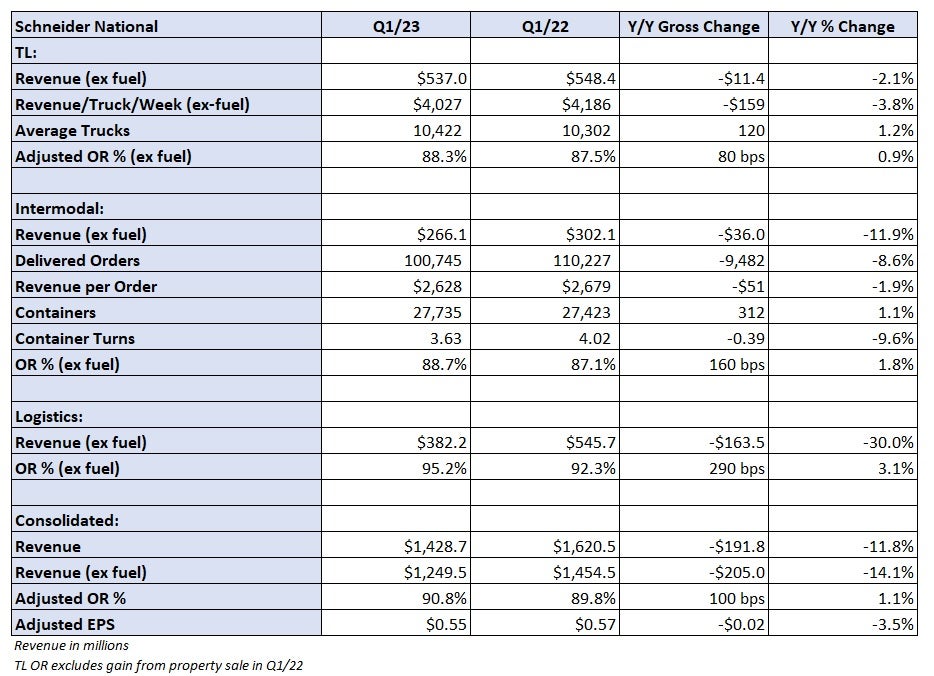Management from Schneider National lowered its outlook for 2023 when it reported first-quarter results on Thursday. The quarter came in better than expected but the truckload carrier said a more material freight recovery won’t likely occur until later in the year.
Schneider (NYSE: SNDR) reported first-quarter adjusted earnings per share of 55 cents, 10 cents ahead of the consensus estimate but 2 cents lower year over year (y/y). The result benefited from a $17.6 million gain from an equity investment, which contributed 7 cents per share.
Full-year adjusted EPS guidance was lowered by 7% at the midpoint of the new range of $2 to $2.20. The range bracketed the consensus estimate of $2.13 at the time of the print. Backing out the equity investment gain in the quarter, the guide was lowered by 10%.
“We now anticipate that the currently challenged freight environment will persist longer than original forecasts,” CFO Steve Bruffett stated in a news release. “Concurrently, there are increasing signals that we are now in the trough of this freight cycle as customer inventories and industry capacity levels continue to rationalize.”
TL capacity to tighten at some point in 2023
Revenue in Schneider’s TL segment was down 2% y/y excluding fuel to $537 million as revenue per truck per week declined 4% and the average truck count increased 1%. An 11% decline in revenue per truck in the one-way segment was only partially offset by a 3% increase in dedicated.
The increase in average tractors was tied to growth in dedicated, which was partially offset by a lower truck count in the one-way fleet. Management said it plans to add several hundred units to the dedicated fleet in 2023 organically and possibly through acquisition.
The TL segment OR was 80 bps worse y/y at 88.3%. The comparison excludes a nonrecurring gain of $50.9 million from a property sale in the year-ago period.
President and CEO Mark Rourke told analysts on a Thursday call that truck capacity is exiting but at a pace slower than originally expected. However, he said the tide is turning as owner-operator lease defaults are on the rise, driver availability has improved and the small carriers that haul for its brokerage unit are struggling.
Rourke said talks with customers show inventory de-stocking is continuing to occur, which is weighing on import volumes. As such, Schneider has more spot freight in its asset-based network than it would like and contractual rate renewals have been lower than planned.
The company expects a tough bid season in the second and third quarters as capacity lingers and demand remains tepid. It noted that small carriers generated excess earnings in the recent peak, more so than in past cycles, likely giving them more reserves and staying power than they’ve had in the past.

Idled intermodal containers amid weakened demand
Intermodal revenue was down 12% y/y excluding fuel as orders declined 9% and revenue per order dipped 2%. Container turns were down to 3.6x in the quarter, a 10% reduction y/y. Approximately 15% of Schneider’s intermodal container fleet was idle in the quarter.
Management sees future mode conversion from truck to rail as a catalyst for the segment in the years to come. The goal is to double the size of its intermodal business by 2030. The company began a new service relationship with Union Pacific (NYSE: UNP) in the West to start the year and just announced an agreement with Canadian Pacific Kansas City (NYSE: CP) to be a service provider on its north-south intermodal line from Mexico to Chicago.
“We’d much rather retain the discipline and just keep a container stacked rather than move it at noncompensatory rates,” Bruffett said.
Brokerage revenue was off 30% y/y as volumes declined 7% and revenue per load was off more than 20%. The unit’s OR was 290 bps worse at 95.2%.
Schneider’s consolidated revenue fell 12% y/y to $1.43 billion. Excluding fuel surcharges, revenue was 14% lower. The company recorded a 90.8% adjusted operating ratio, which was 100 basis points worse y/y.
The 55 cent first-quarter result also included a $2 million y/y increase in gains on equipment sales, which added 1 cent. A lower tax rate also added a penny. However, the higher interest rate environment was a 1 cent headwind as interest expense increased $1.6 million on a very small increase in outstanding debt.
The new full-year guidance assumes flat gains on equipment sales, which were $27 million in 2022.
“The current market condition has introduced a higher degree of freight volume recovery uncertainty from a timing perspective,” Rourke said. “However, we do expect an improvement in freight volumes into a moderating capacity condition in the latter portion of 2023.”
More FreightWaves articles by Todd Maiden
- Landstar sees April step down but says bottom is near
- Old Dominion’s Q1 miss sends LTL stocks lower
- Teamsters add seat on Yellow’s board










